
The Apodiformes is an order, or taxonomic grouping, of birds which traditionally contained three living families—the Apodidae (swifts), the Hemiprocnidae (treeswifts), and the Trochilidae (hummingbirds); however, in the Sibley-Ahlquist taxonomy, this order is elevated to the superorder Apodimorphae, in which hummingbirds are separated into a new order, the Trochiliformes. With nearly 450 species identified to date, it is the most diverse order of birds after the Passeriformes.

The rufous-breasted hermit or hairy hermit is a hummingbird that breeds from Panama south to Bolivia, and on Trinidad, Tobago and Grenada. It is a widespread and generally common species, though local populations may change in numbers and disappear altogether in marginal habitat.

The hermits are tropical and subtropical hummingbirds in the subfamily Phaethornithinae, comprising 37 species in six genera. They occur from southern Mexico, through Central America, to South America as far south as northern Argentina.

Phaethornis is a genus of hummingbirds in the hermit subfamily, Phaethornithinae. They occur from southern Mexico, through Central America, to South America as far south as northern Argentina.

Trochilinae is one of the six subfamilies that make up the hummingbird family Trochilidae.

Boissonneaua is a small genus of hummingbirds in the family Trochilidae. They are found in humid Andean forests from western Venezuela to southern Peru. They have a straight black bill, contrasting outer rectrices, and a distinctive habit of quickly lifting both wings up shortly after landing, thereby revealing their rufous underwing coverts.

Chlorostilbon is a genus of hummingbird in the family Trochilidae, known as emeralds. A single species, the blue-chinned sapphire is variously placed in the monotypic genus Chlorestes or in Chlorostilbon. The taxonomy of the C. mellisugus superspecies is highly complex and, depending on view, includes 1-8 species. All species in this genus have straight black or black-and-red bills. The males are overall iridescent green, golden-green or bluish-green, and in some species the tail and/or throat is blue. The females have whitish-grey underparts, tail-corners and post-ocular streak.

Cynanthus is a genus of hummingbird in the family Trochilidae.

Eutoxeres is a genus of hummingbird in the family Trochilidae.
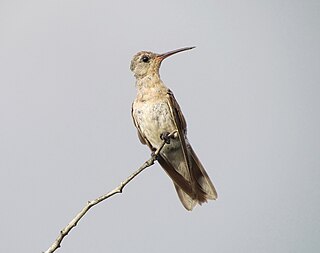
The buffy hummingbird is a species of bird in the hummingbird family Trochilidae. It is the only species placed in the genus Leucippus. This bird lives in dry forest and scrubland in northern South America where it feeds on insects and the nectar, flesh, and juice of cactus fruits.
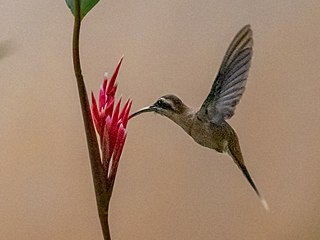
The cinnamon-throated hermit is a species in the hummingbird family Trochilidae. It is found in Bolivia and Brazil.
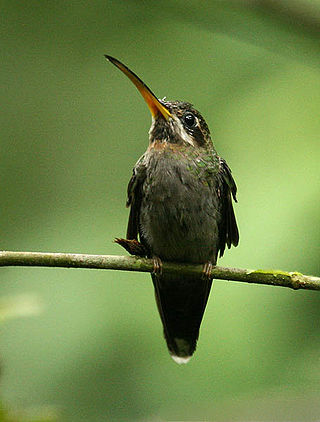
The barbthroats are a genus Threnetes of South American hummingbirds in the family Trochilidae.

The sooty barbthroat is a hummingbird species in the family Trochilidae. It is found in Brazil and French Guiana.
Eurotrochilus is an extinct genus of stem group hummingbirds (Trochilidae) and are the closest known relatives of the crown group Trochilidae. Despite Eurotrochilus being morphologically very similar to modern hummingbirds, they still retained several primitive features and are not closely related to any specific extant hummingbird in the crown group. There are currently two described species of Eurotrochilus: E. inexpectatus and E. noniewiczi.

The Ricinidae are a family of a larger group Amblycera of the chewing lice. All species are relatively large bodied avian ectoparasites. They typically exhibit low prevalence and low intensity. They feed on host blood which is atypical in chewing lice. Two or three genera are recognized.
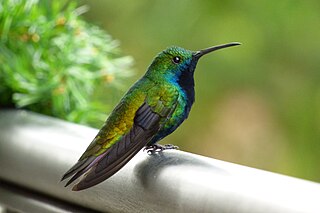
Polytminae is one of the six subfamilies of the hummingbird family Trochilidae. The subfamily contains 12 genera with a total of 29 species.
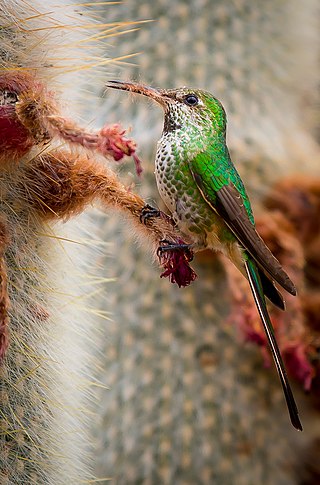
Lesbiinae is one of the six subfamilies that make up the hummingbird family Trochilidae.

Heliantheini is one of the two tribes that make up the subfamily Lesbiinae of the hummingbird family Trochilidae. The other tribe in the subfamily is Lesbiini.

Lesbiini is one of the two tribes that make up the subfamily Lesbiinae in the hummingbird family Trochilidae. The other tribe is Heliantheini (brilliants).

Trochilini is one of the three tribes that make up the subfamily Trochilinae in the hummingbird family Trochilidae. The other two tribes in the subfamily are Lampornithini and Mellisugini (bees).


























